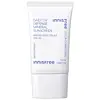What's inside
What's inside
 Key Ingredients
Key Ingredients

 Benefits
Benefits

 Concerns
Concerns

 Ingredients Side-by-side
Ingredients Side-by-side

Zinc Oxide 17%
Cosmetic ColorantWater
Skin ConditioningPropylheptyl Caprylate
EmollientButyloctyl Salicylate
Skin ConditioningPropanediol
SolventCaprylyl Methicone
Skin ConditioningDisiloxane
Skin ConditioningPolyglyceryl-3 Polydimethylsiloxyethyl Dimethicone
Skin ConditioningPolymethylsilsesquioxane
Polyglyceryl-2 Dipolyhydroxystearate
Skin ConditioningDisteardimonium Hectorite
StabilisingMagnesium Sulfate
Triethoxycaprylylsilane
1,2-Hexanediol
Skin ConditioningSilica
AbrasiveLauryl Polyglyceryl-3 Polydimethylsiloxyethyl Dimethicone
Skin ConditioningSynthetic Fluorphlogopite
Dicaprylyl Carbonate
EmollientCaprylyl Glycol
EmollientGlyceryl Caprylate
EmollientCI 77288
Cosmetic ColorantMica
Cosmetic ColorantEthylhexylglycerin
Skin ConditioningSodium Hyaluronate
HumectantTocopherol
AntioxidantSqualane
EmollientCeramide NP
Skin ConditioningNiacinamide
SmoothingHydrolyzed Sodium Hyaluronate
Skin ConditioningPanthenol
Skin ConditioningButylene Glycol
HumectantCentella Asiatica Extract
CleansingCentella Asiatica Leaf Extract
Skin ConditioningSaccharomyces Ferment
Skin ConditioningCentella Asiatica Root Extract
Skin ConditioningHydroxypropyltrimonium Hyaluronate
Asiaticoside
AntioxidantMadecassoside
AntioxidantHydrolyzed Hyaluronic Acid
HumectantSodium Acetylated Hyaluronate
HumectantHyaluronic Acid
HumectantSodium Hyaluronate Crosspolymer
HumectantPotassium Hyaluronate
Skin ConditioningAsiatic Acid
Skin ConditioningMadecassic Acid
Skin ConditioningZinc Oxide 17%, Water, Propylheptyl Caprylate, Butyloctyl Salicylate, Propanediol, Caprylyl Methicone, Disiloxane, Polyglyceryl-3 Polydimethylsiloxyethyl Dimethicone, Polymethylsilsesquioxane, Polyglyceryl-2 Dipolyhydroxystearate, Disteardimonium Hectorite, Magnesium Sulfate, Triethoxycaprylylsilane, 1,2-Hexanediol, Silica, Lauryl Polyglyceryl-3 Polydimethylsiloxyethyl Dimethicone, Synthetic Fluorphlogopite, Dicaprylyl Carbonate, Caprylyl Glycol, Glyceryl Caprylate, CI 77288, Mica, Ethylhexylglycerin, Sodium Hyaluronate, Tocopherol, Squalane, Ceramide NP, Niacinamide, Hydrolyzed Sodium Hyaluronate, Panthenol, Butylene Glycol, Centella Asiatica Extract, Centella Asiatica Leaf Extract, Saccharomyces Ferment, Centella Asiatica Root Extract, Hydroxypropyltrimonium Hyaluronate, Asiaticoside, Madecassoside, Hydrolyzed Hyaluronic Acid, Sodium Acetylated Hyaluronate, Hyaluronic Acid, Sodium Hyaluronate Crosspolymer, Potassium Hyaluronate, Asiatic Acid, Madecassic Acid
Zinc 12%
AntioxidantAloe Barbadensis Leaf Juice
Skin ConditioningThioctic Acid
AntioxidantMagnesium Ascorbyl Phosphate
AntioxidantPanthenol
Skin ConditioningTocopheryl Acetate
AntioxidantErgocalciferol
Skin ConditioningVitis Vinifera Seed Extract
AntimicrobialOenothera Biennis Oil
EmollientHelianthus Annuus Seed Oil
EmollientCarthamus Tinctorius Seed Oil
MaskingUlmus Fulva Bark Extract
MoisturisingBorago Officinalis Seed Oil
EmollientBisabolol
MaskingPlantago Major Callus Extract
Skin ConditioningAllantoin
Skin ConditioningHyaluronic Acid
HumectantSqualane
EmollientZinc 12%, Aloe Barbadensis Leaf Juice, Thioctic Acid, Magnesium Ascorbyl Phosphate, Panthenol, Tocopheryl Acetate, Ergocalciferol, Vitis Vinifera Seed Extract, Oenothera Biennis Oil, Helianthus Annuus Seed Oil, Carthamus Tinctorius Seed Oil, Ulmus Fulva Bark Extract, Borago Officinalis Seed Oil, Bisabolol, Plantago Major Callus Extract, Allantoin, Hyaluronic Acid, Squalane
 Reviews
Reviews

Alternatives
Ingredients Explained
These ingredients are found in both products.
Ingredients higher up in an ingredient list are typically present in a larger amount.
Hyaluronic acid is naturally found in healthy skin. It is a humectant, meaning it draws moisture to your skin.
This ingredient helps hydrate, soothe, and protect the skin.
What makes hyaluronic acid so hydrating? It has the capacity to bind or hold large amounts of water.
Fun fact: It is already naturally found in our bodies, such as the fluids of our eyes and our joints.
Studies find this ingredient to have anti-inflammatory and anti-microbial properties. This can help speed up wound-healing.
Hyaluronic acid can be irritating if the molecule has a low-molecular weight, or if the molecules are small.
One study found low-molecular weight hyaluronic acid to be pro-inflammatory, meaning some people may experience irritation. This is because our bodies use hyaluronic acid in the wound-healing process to signal to our bodies, via irritation, that something needs healing.
The same study found high-molecular weight hyaluronic acid to be anti-inflammatory.
These are some other common types of Hyaluronic Acid:
Learn more about Hyaluronic AcidPanthenol is a common ingredient that helps hydrate and soothe the skin. It is found naturally in our skin and hair.
There are two forms of panthenol: D and L.
D-panthenol is also known as dexpanthenol. Most cosmetics use dexpanthenol or a mixture of D and L-panthenol.
Panthenol is famous due to its ability to go deeper into the skin's layers. Using this ingredient has numerous pros (and no cons):
Like hyaluronic acid, panthenol is a humectant. Humectants are able to bind and hold large amounts of water to keep skin hydrated.
This ingredient works well for wound healing. It works by increasing tissue in the wound and helps close open wounds.
Once oxidized, panthenol converts to pantothenic acid. Panthothenic acid is found in all living cells.
This ingredient is also referred to as pro-vitamin B5.
Learn more about PanthenolSqualane is an emollient that helps the skin hold onto moisture. It's an oily liquid that occurs naturally in certain types of fish and plant oils.
Because squalane boosts hydration in the skin, it also comes with plenty of benefits: it is an antioxidant and can help fight free radicals and skin damage. Squalane is also found to have a detoxifying effect when applied.
Squalane comes from squalene, which occurs naturally within the sebum of our skin. It is one of the oils our skin produces to keep itself hydrated. Squalane is the hydrogenated version of squalene and has a longer shelf life.
Research shows that squalane is non-irritating (even at 100% concentration).
In general, it's a fantastic ingredient. It does a great job at hydrating the skin, and it's suitable for those with sensitive skin.
The source of squalane may impact malassezia / fungal acne. This is because olive oil derived squalane can contain impurities such as fatty acids and plant waxes. Sugarcane derived squalane is recommended for anyone with malassezia concerns.
Is squalane vegan?
This depends on the source. Squalane can be derived from both plants and animals. Most squalane used in skincare comes from plants.
Please note: the source of squalane is only known if disclosed by the brand. We recommend reaching out to the brand if you have any questions about their squalane.
Read more about squalene with an "e".
Is squalane an oil?
Squalane is often called an oil, but it’s technically not; it’s a hydrocarbon, meaning it’s only made of carbon and hydrogen, unlike true oils which are triglycerides made of fatty acids and glycerol.
The term “oil-free” isn’t regulated, so companies can define it however they want. Some exclude all oils, while others just avoid mineral oil or comedogenic oils.
While some people avoid oils thinking they cause breakouts, the right kind of oil (or oil-like ingredient like squalane) can actually help balance and hydrate your skin. It’s worth testing out simple oils or squalane to see what works best for your skin.
Learn more about Squalane